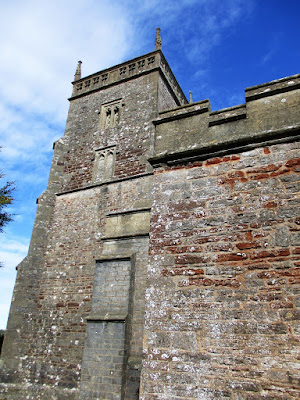Nah, I'm bored with that ... and with these keyhole squeeze stiles. I mean, they might be OK for pugs, but they are no friend to the older, more statesmanlike dog, and Ted - who has yet to realise he can jump - had to suffer the ignominy of being carried over.
First, though, the 12th century Church of St Laurence ...
... which has the distinction of being the only one I've visited with a tomb in its porch.
Sir John Newton, who died in 1568, was evicted from the spot where the altar stands in 1883. Along the bottom of his tomb are ranged his 20 children, twelve daughters and eight sons.
There's a lovely soft light in St Laurence Church which was evident the moment Ted and I set foot (and paw) in it.
I think this beautiful, ancient window has something to do with it.
Next to it is the outstanding Great War Memorial window depicting St George flanked by St Laurence and St Agnes, by Arts and Crafts stained glass artist, Karl Parsons.
The dragon wouldn't disgrace Daenerys Stormborn ...
... though my favourite detail right at the bottom of the central panel is the illustration of a mother and child waving farewell to a man setting off to fight in France.
I also loved the bench ends, a few of which date from the 14th century ...
... especially the honest way in which they've been repaired, with no attempt to dupe or deceive.
Outside the difference in height between the churchyard and the surrounding field is accounted for by the large number of burials.
 My walking book was quite eloquent on the loveliness of the combe ...
My walking book was quite eloquent on the loveliness of the combe ...... but omitted to mention how muddy it is. Within a few yards, I was wishing I'd worn my stoutest walking boots - or even wellies.
We pressed on - well, I did; Ted, being a border collie, really didn't care - and before long we encountered the East Harptree aqueduct, a feat of engineering dating from 1851 and still instrumental in providing water to Bristol today.
However, it couldn't compete with the 11th century motte and bailey castle also in the vicinity.
Up there somewhere, in fact.
I re-acquainted myself with the few known facts. The original owner was one Azeline de Percheval, who came over with William the Conqueror and whose cruelty earned him the sobriquet 'Lupus' or 'the Wolf'. After passing to his son - unpromisingly called 'the Wolf Cub' - it eventually came into the ownership of the de Harptree family, and was held for the Empress Matilda in 1138 by Sir William against Stephen, who only managed to take it by luring the defenders out. It was destroyed during the reign of Henry VIII.
For me, however, the most compelling thing about it was that it was described as 'inaccessible'.
 The route up didn't look bad from the bottom - until a few feet from the top where I had to resort to proper hand and foot climbing.
The route up didn't look bad from the bottom - until a few feet from the top where I had to resort to proper hand and foot climbing. Once up, however, I had the nasty feeling that I wouldn't be able to get back down - not even by sliding on my bum.
Rumour has it there is still some masonry to be found under the vegetation, but all I saw was a series of earthworks, some of which pertain to the castle and some to the calamine workings which went on spasmodically until the 19th century.
I felt thankful that when my kids were poxy, I just had to go to the local chemist.
Considering the steepness of the motte, I decided to leave the rest of the combe until bluebell time next year and consulted my map to see if there was a way down that didn't involve risking my neck.
I'll check the map first next time.
























What a lovely trip out... Beautifully photographed.
ReplyDeleteThanks, cuz x
Delete